marqueta.org
You can't always apt-get what you want
Infosec - Cycling - Estudiantes
RHCE / RHCSA
Once a sysadmin, always a sysadmin
Day 5: From la Maragatería to El Bierzo
May 28, 2024
I had a good sleep. A bit “noisy” due to a roommate, but I rested well. As the days go by the body starts to adapt and instead of getting more tired each day, you feel less so. At least that’s my impression.
Yesterday I didn’t take the precaution of buying something for breakfast; in the albergue there are some little things but I prefer to leave on an empty stomach and stop in Rabanal del Camino, about 6 km from the start. Today it’s time to climb the Cruz de Ferro, the highest point of the French Way and one of its most iconic landmarks.
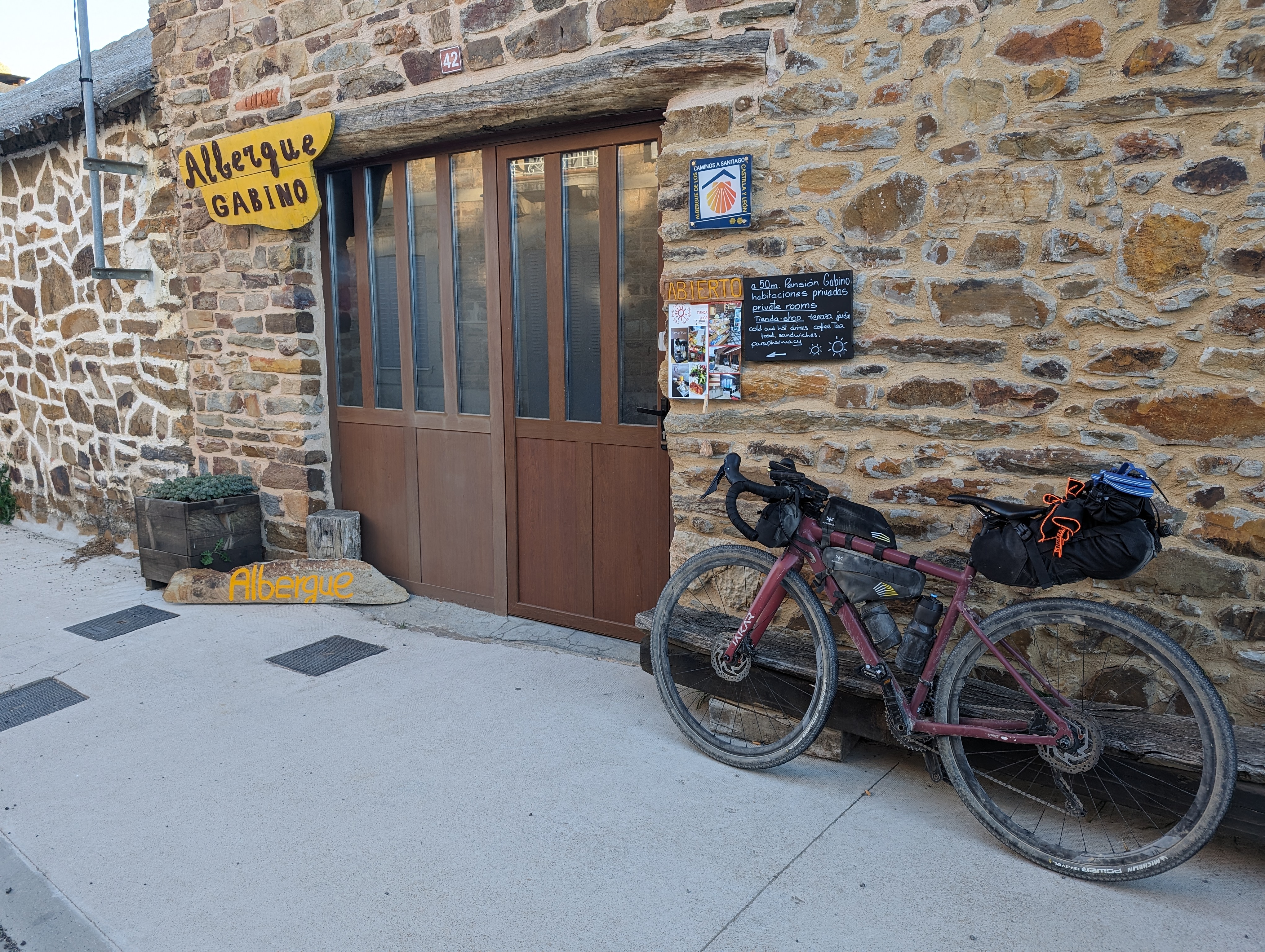
All ready to go
I pick up the stuff and around 7:45 am I’m ready to leave. Strange thing, today I’m one of the first to get going. In front of me only the woman from Michigan has left, with whom I still have time to exchange a few words and share a few laughs as I pass her by.
It is a beautiful day. I can’t help but remember my previous trip, when rain, fog and cold prevented me from enjoying this stage. I had a really bad time, but today was going to be very different.
From El Ganso it’s about 15 kilometres to Cruz de Ferro, with about 500 metres of elevation gain. It’s a long but straightforward pass, with no big ramps. Nothing to do with O Cebreiro, which will be tomorrow. For the moment I set a very slow pace on the road to Rabanal, where I stop for breakfast: coffee, a pincho de tortilla and a banana. I share breakfast with a pilgrim from Madrid who is on his third attempt to finish his pilgrimage to Santiago; different incidents - whether illness or injury - prevented him from doing so on previous occasions.
And this brings me to a discussion I had with several people along the way; there seems to be no reliable data on how many people start and, for various reasons, are unable to finish. But it must be a lot. The woman from Michigan said yesterday at the albergue that, of the seven people with whom she engaged in conversation on her first day in Roncesvalles, only two were left in the Camino. The rest had had some impediment, usually injury or illness; and, in one case, it was simply a loss of motivation that led one person to give up.
I say goodbye to the madrileño who I leave complaining (perhaps with some reason) about the prices; it’s true that, in some places, they squeeze the pilgrim a bit but I understand that for many it’s their way of making a living and that there are alternatives for those who are not happy with it.
As I pass a fountain I realise that I have forgotten to refill the bottles so I stop to get some water. When I get back on the road I meet a Belgian cyclist who is cycling from home. We do a section of the climb together and he tells me that he set off about three weeks ago and that he averages 100 km and 1.000 m of elevation gain per day. After a while of chatting, I encourage him to continue at his own pace, as it’s obvious that he’s faster than me. We would meet again later on.
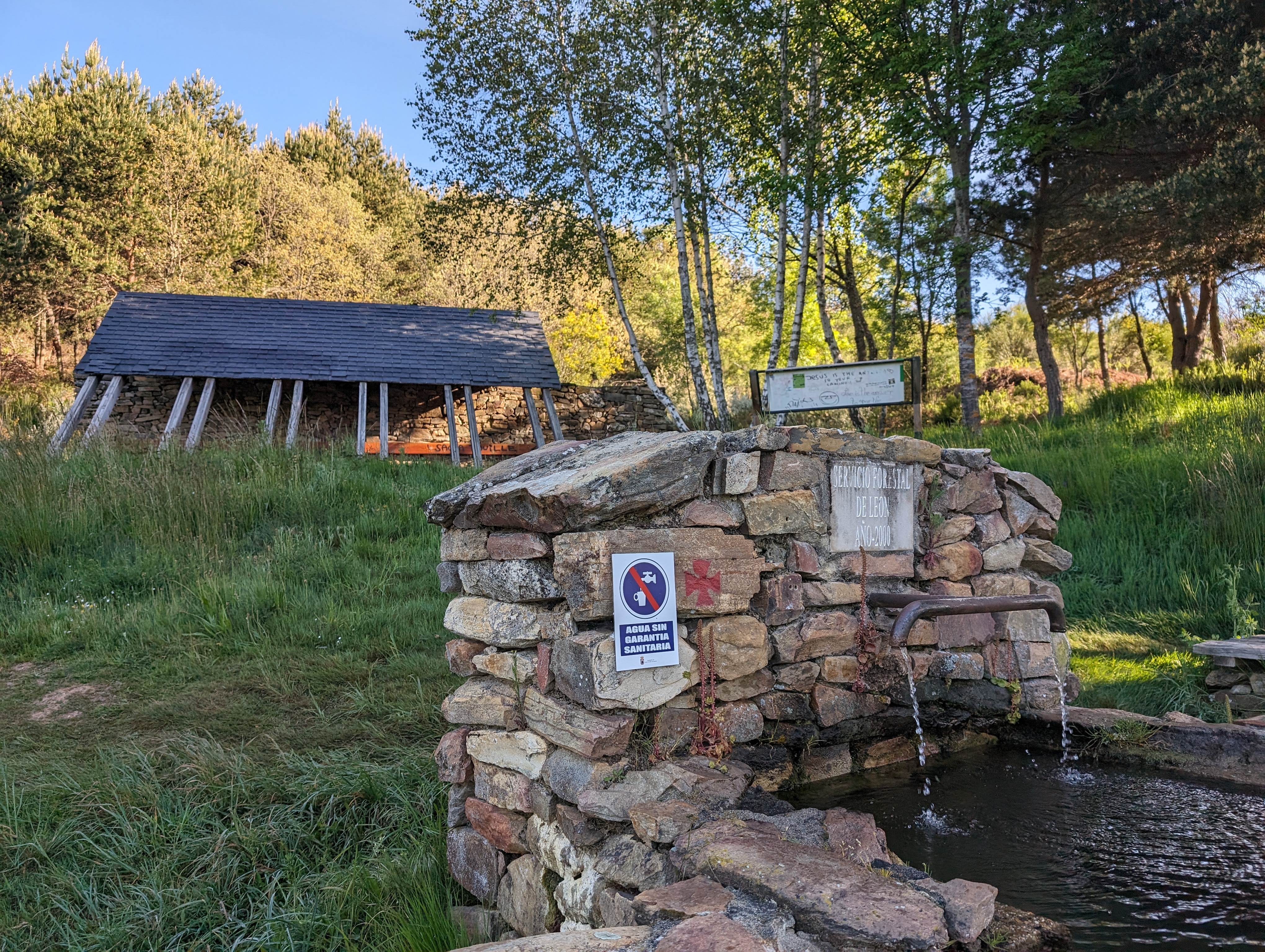
Cojo agua en la fuente
Little by little, at a slow pace, I reach Foncebadón, the last village before the top of the climb. At the exit of the village are the steepest slopes, but they never reach double digits. Before the cross there is a small descent that makes me think that the highest point of the French Way is not exactly at the Cross but a few hundred metres before it.
Including breakfast and the stops, it took me an hour and a quarter to reach the Cruz de Ferro. When I arrive there is still the Belgian cyclist and a couple of people from Leon with e-bikes with whom I think I had met sometime the day before.
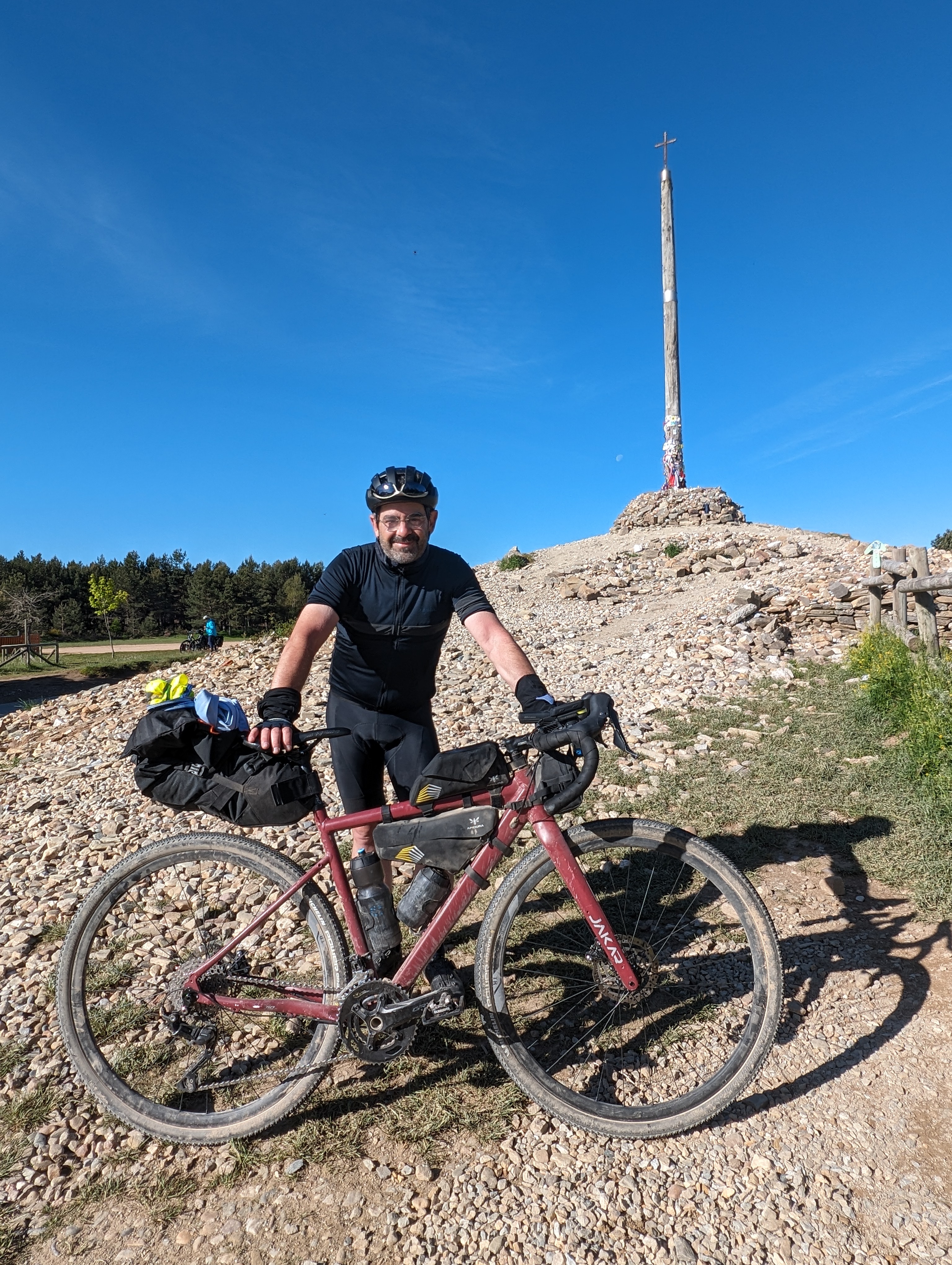
Cruz de Ferro
The pile of stones is a response to ancient traditions; in general, they are stones brought by pilgrims from their places of origin and left there as thanks, as an offering or as a representation of leaving their burden there, whatever it may be. There are many different stories to explain this.
I stop for a while to enjoy the beautiful morning and take the opportunity to adjust my cleats; meanwhile, I have a memory for Luis and I wonder if he (unlike me) would carry a stone to his Caminos.
The descent of the pass is very long, but it doesn’t start at the cross; on the contrary, there are still a couple of kilometres of steep slopes, some with peaks of 13% (whenever I say this, Perico Delgado and his particular way of describing the passes comes to mind: “…slopes of 7, 8 and 9 per cent with peaks of 10, 11 and even 12 but reaching 13%…”).
On the way to Manjarín, I stopped for a while at the refuge of Tomás, “the last Templar”, with the excuse of stamping my credential. I said refuge because that’s what it is, not an albergue. It’s there for those who have an emergency, which can happen at these altitudes; to get an idea, there are no toilets or showers. Tomás is a peculiar guy with whom I had a nice conversation. From what I read later, he is half “retired” and no longer lives in the refuge, although he didn’t mention it during the time he was telling stories. Come to think of it, I’m not even 100% sure that it was Tomás and not one of his colleagues who look after the shelter.
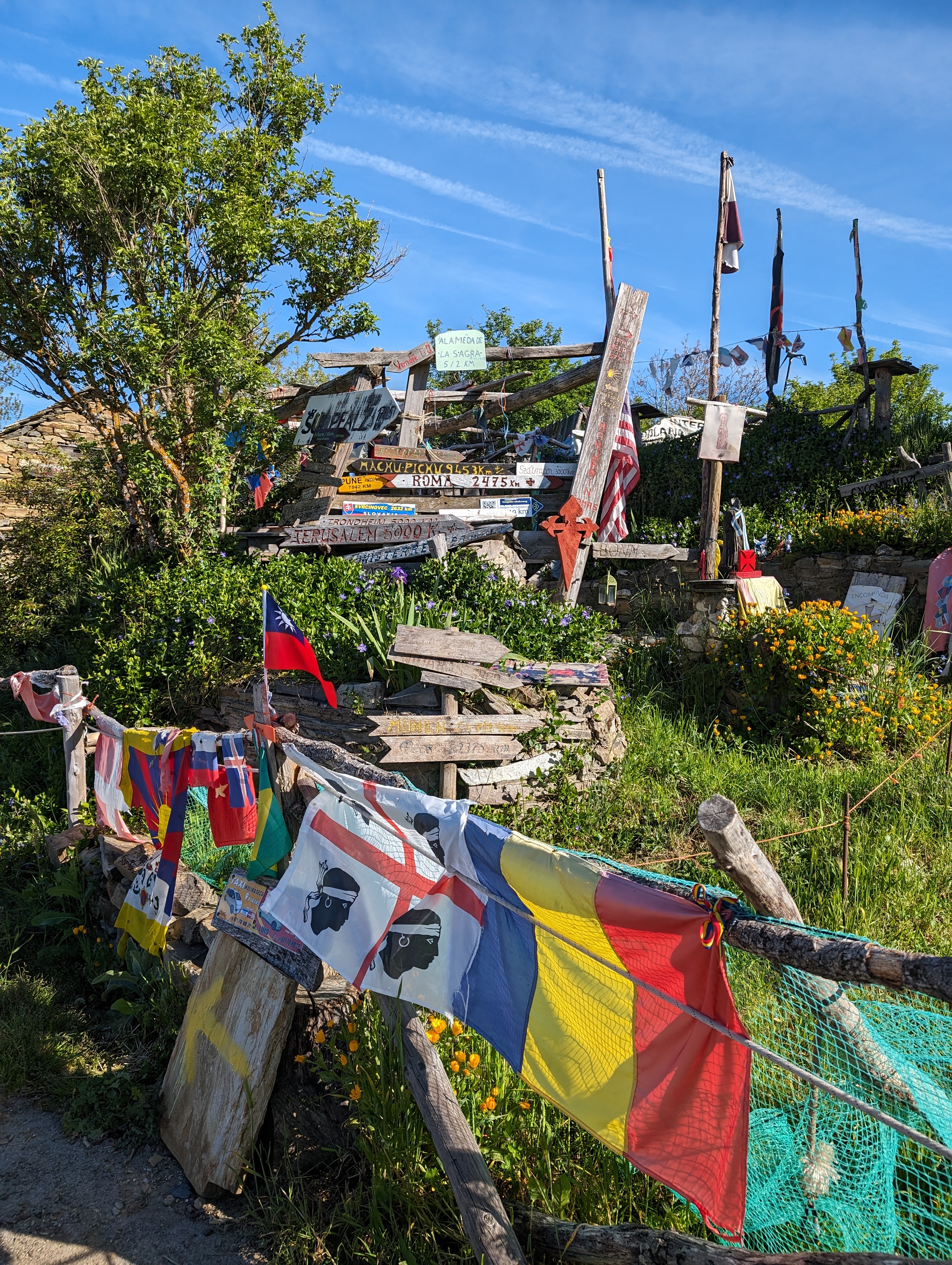
Tomás’s refuge in Manjarín
Once past the steep area, the descent finally begins, which is long and steep; if the Foncebadón pass is very pleasant on the way to Santiago, on the way back it must be a monster. The scenery is marvellous and new to me, as the rain and fog of the previous trip had prevented me from admiring it.
I pass by El Acebo - where I only stop to refill water - and Riego de Ambrós, the destination for many of the pilgrims on foot after passing the Cruz de Ferro. But I want to advance until I stay as close as possible to O Cebreiro.
The long descent ends in Molinaseca; I cross the village, also without stopping, and continue by road to the nearby capital of El Bierzo, Ponferrada. The imposing Templar castle is an obligatory stop.
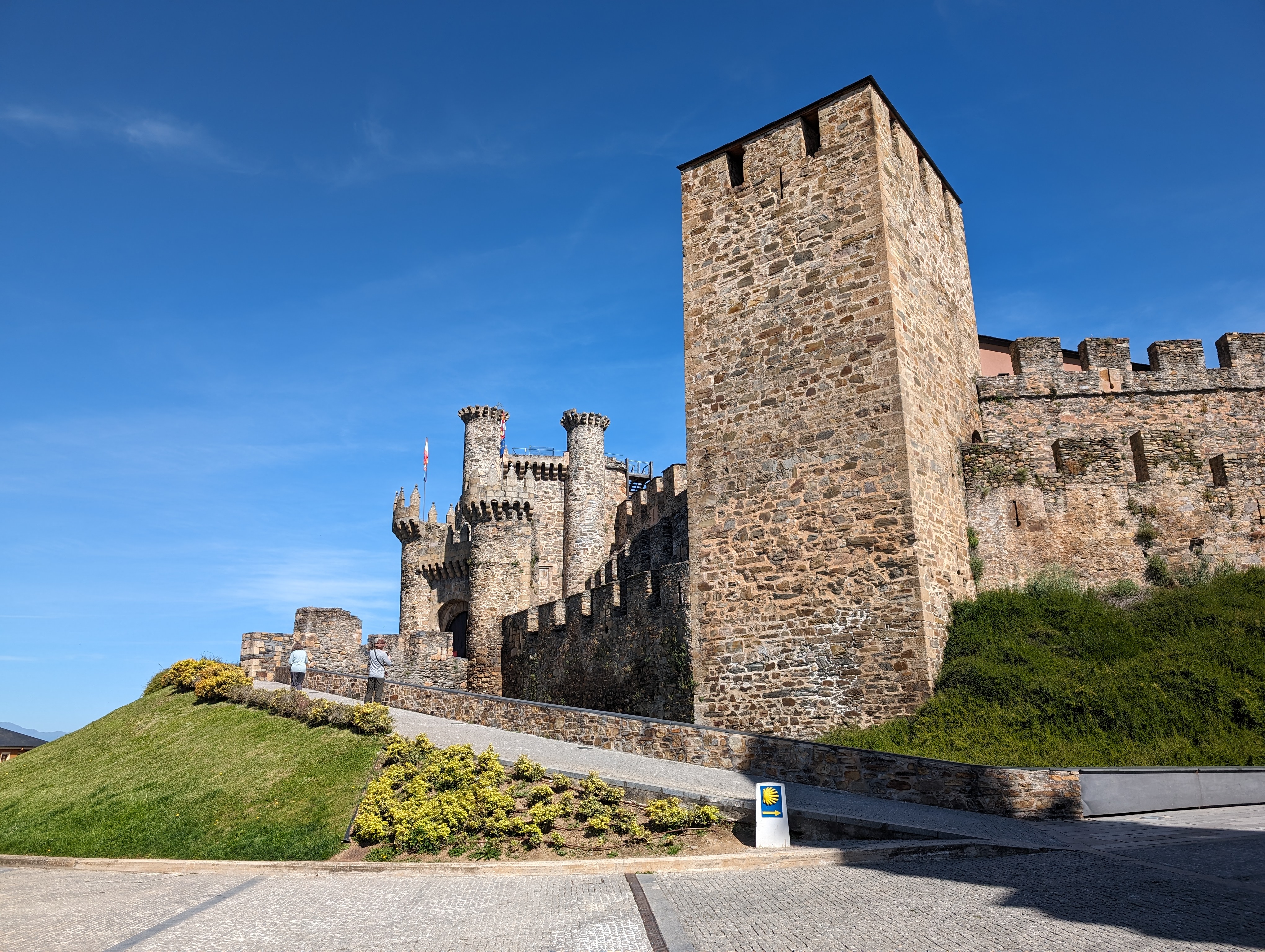
Ponferrada Templar castle
I go into a bar next to the castle with the intention of having lunch, but after a while without being served I decide to leave and continue my journey.
Today is a very tarmac day and I continue by road through the towns of Fuentesnuevas and Camponaraya, where I take a stretch of track that, among vineyards, brings me closer to Cacabelos.

Less than 200 km to go
Cacabelos is a town tremendously rich in history in which, nowadays, wine is of great importance. For example, it is the headquarters of the Consejo Regulador de la D.O. Bierzo, which has a unique building in the middle of the Camino.

Headquarters of Consejo Regulador de la D.O. Bierzo
It’s one of those places that I’m looking forward to enjoying more calmly; let’s see when a weekend in Ponferrada and Cacabelos comes around…
But, for the moment, I continue on my way and continue, again by road, towards Villafranca del Bierzo. There I had my worst moment of the Camino in 2022, when I thought I was going to give up because of the heavy rains. Today the day is beautiful, perhaps a little too hot for the time of year. It’s time for lunch and I find an appetising pilgrim menu in the bar El Castillo, opposite the castle-palace of the Marqueses de Villafranca. I eat a pasta dish, a second dish that I can’t remember, ice cream and coffee.
I spent the after-lunch conversation with a strange and friendly German pilgrim, born in the city that doesn’t exist. The guy told me that he was a well-respected engineer in a large technology company and that he decided to retire young and live modestly on his pension and savings. He told it so well that it made me want to follow him, although I don’t know if I would dare to do so.
As usual, I use the lunch break to look for accommodation. My idea was to get as close as possible to O Cebreiro, so I start looking in Las Herrerías, but I have to go back to La Portela, and thank heavens for that! The truth is that it’s not easy to find accommodation; surely it’s possible to continue because not all albergues or accommodation in general are online. But I also didn’t want to risk having to climb O Cebreiro after almost 100 km and in more than 30 degrees.
With a reservation at an accommodation with a curious name and 14 kilometres to go, I started off again. Shortly after leaving, I find a familiar landmark and take a photo almost identical to the one from the previous trip:
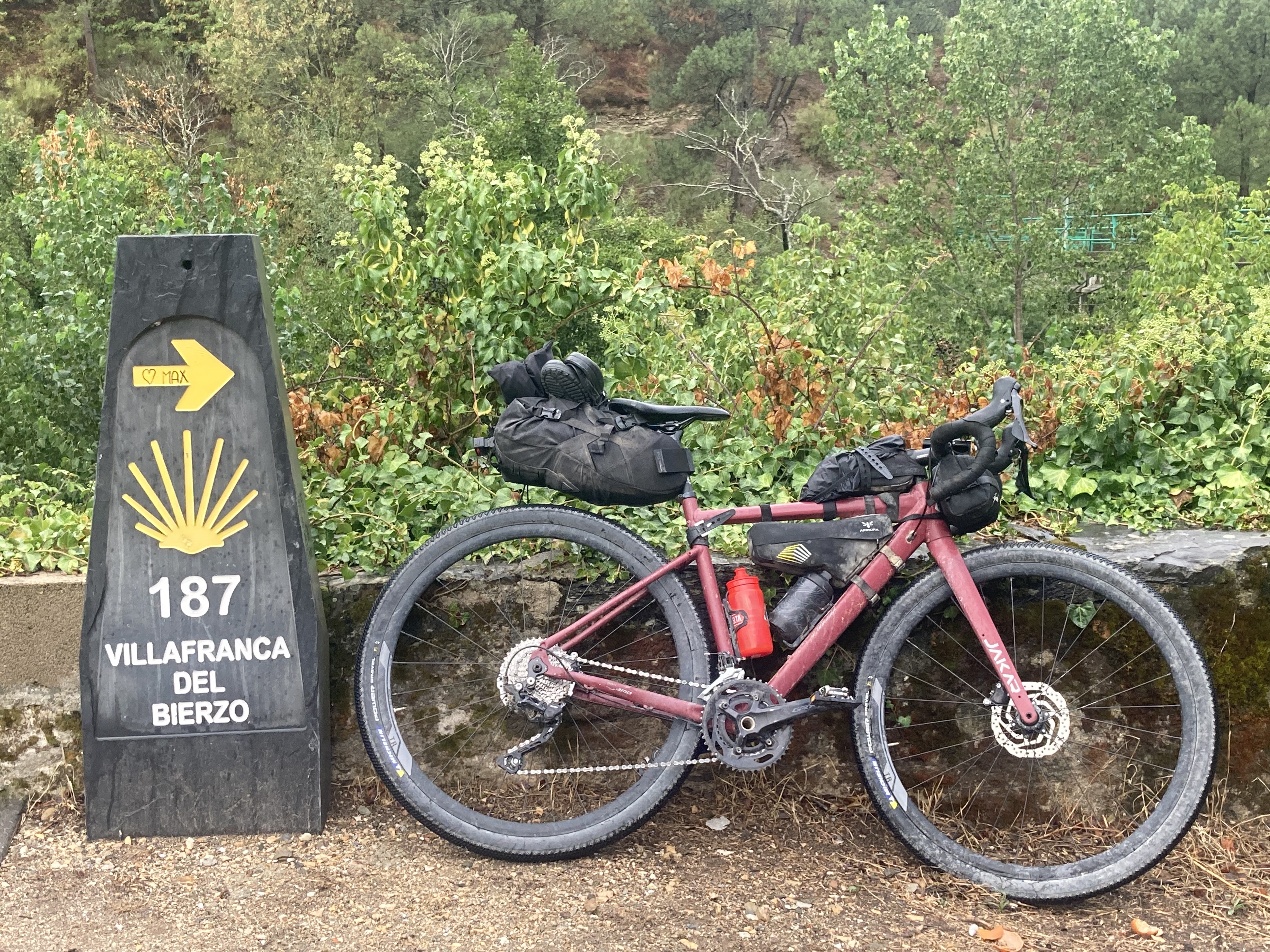
187 km (2022)

187 km (2024)
Leaving Villafranca del Bierzo you take the old N-VI, but the walkway (shared with the bikes) is totally separated from the cars by a concrete wall. It is a very good solution.
However, in this section I almost had a small incident due to a widespread habit among pilgrims: walking with headphones.
I want to make it very clear from the beginning that respect for pilgrims on foot must be absolute and their priority must be respected. It is ESSENTIAL to use the bell. And it is not enough to warn them, it is necessary to make sure that they have heard and that they know that a bicycle is going to pass. Of course, you have to slow down, keep in step and, when necessary, get off the bike.
But all precautions are useless if, no matter much you ring the bell or shout at them, they are totally isolated from their surroundings by their headphones.
Well, this happened to me with a Korean pilgrim. I used the bell, shouted at him several times… nothing. At his pace, pushing the bike with my feet (no longer pedalling) I started to overtake him; he was so absorbed that he got scared, pushed me and I was close to falling down a slope and hurting myself. I calmly tried to make him see that it wasn’t a good idea to wear the headphones; he apologised a thousand times… but no, he didn’t take them off.
The proximity to Galicia is already noticeable; the landscape is getting greener and lusher and oak and chestnut trees are becoming more and more frequent. The route crosses the road several times as it passes through Pereje and Trabadelo, following the course of the river Valcarce. At the entrance to the next village, La Portela, I find this sign:
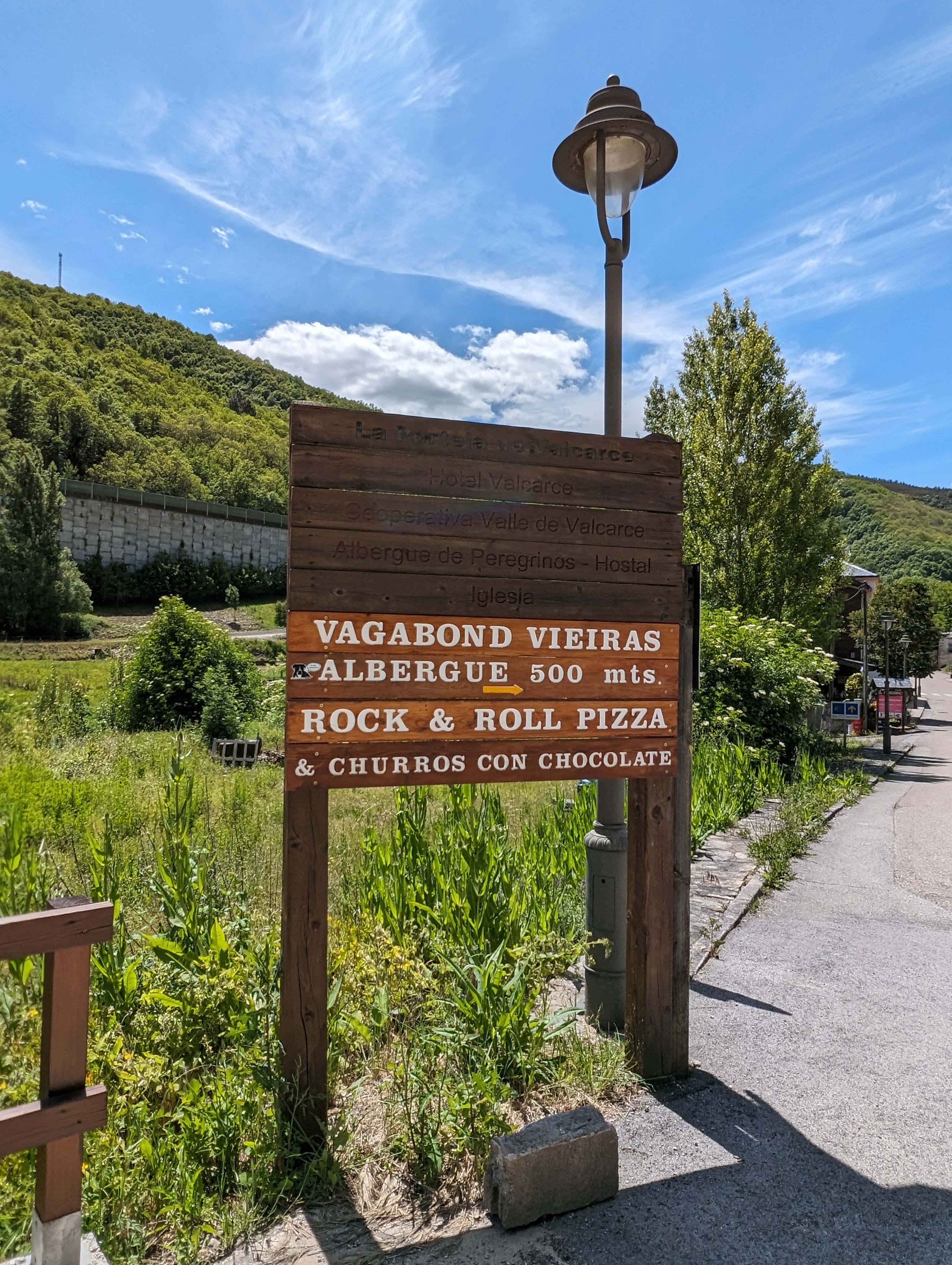
Buen nombre para un albergue
That was going to be my albergue, and I was really intrigued. I still had to cross the village as it is just outside the town. On the terrace I was greeted by a Brazilian girl to whom, in a mixture of English and Spanish, I explained that I already had a reservation.
Joshua, an Australian volunteer, was the one who showed me where the room was that I would share with three other pilgrims. He had come to Spain with the intention of learning the language and was somewhat frustrated that there were hardly any Spanish pilgrims to talk to. And he was right; today was my fifth night on the Camino and I had only met one Spaniard pilgrim!
Little by little the name of the albergue and its decoration made sense. David, the owner, was an old L.A. rocker (albeit a New Yorker by birth) who owned a small pizza business. When he discovered the Camino, he franchised his pizza shops and bought a house in La Portela where he set one up; but not only that, he also frequently hosts rock concerts. Here you can read his story and on his Instagram account you can keep up to date with the concerts.
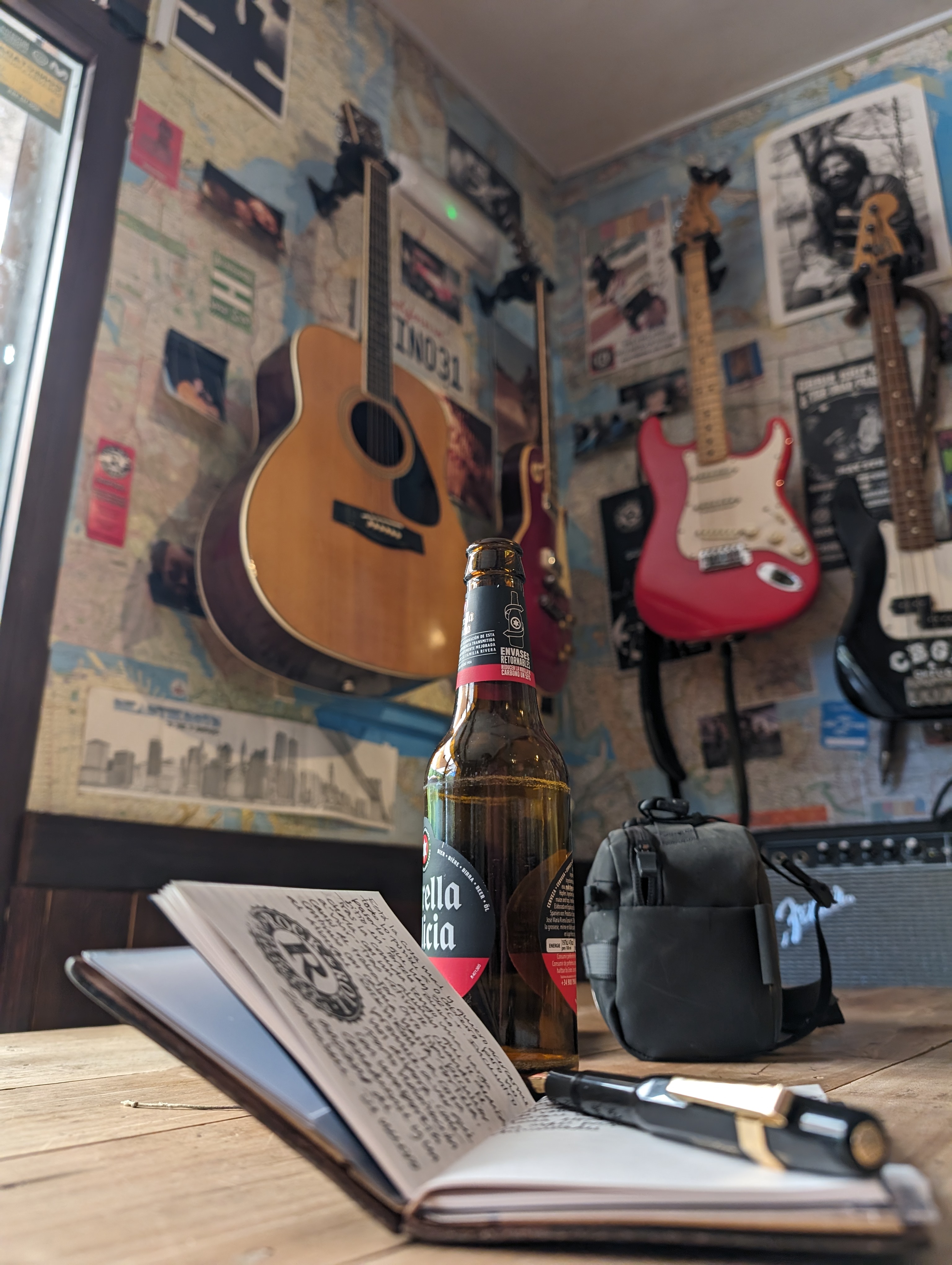
Escribiendo junto a las viejas guitarras de David
I sat quietly writing my notes while I waited for dinner time (half past six in the evening). On the porch we all sat at a long table, including David, his partner and the Brazilian friend who had looked after me when I arrived. In addition, there was Joshua (the Australian volunteer), a girl and a man from Quebec (by chance, they didn’t know each other), an older couple from Texas, a New Zealand woman and an old man from Zimbabwe. At Joshua’s request, we held hands to thank God for the meal.
Dinner consisted of various salads and the speciality of the house: pizza. I’m no connoisseur, but I thought the pizzas were delicious. As proof, the Texan couple who had stayed at the hostel the night before and who today, from the destination of their day’s stage, took a taxi back to eat.
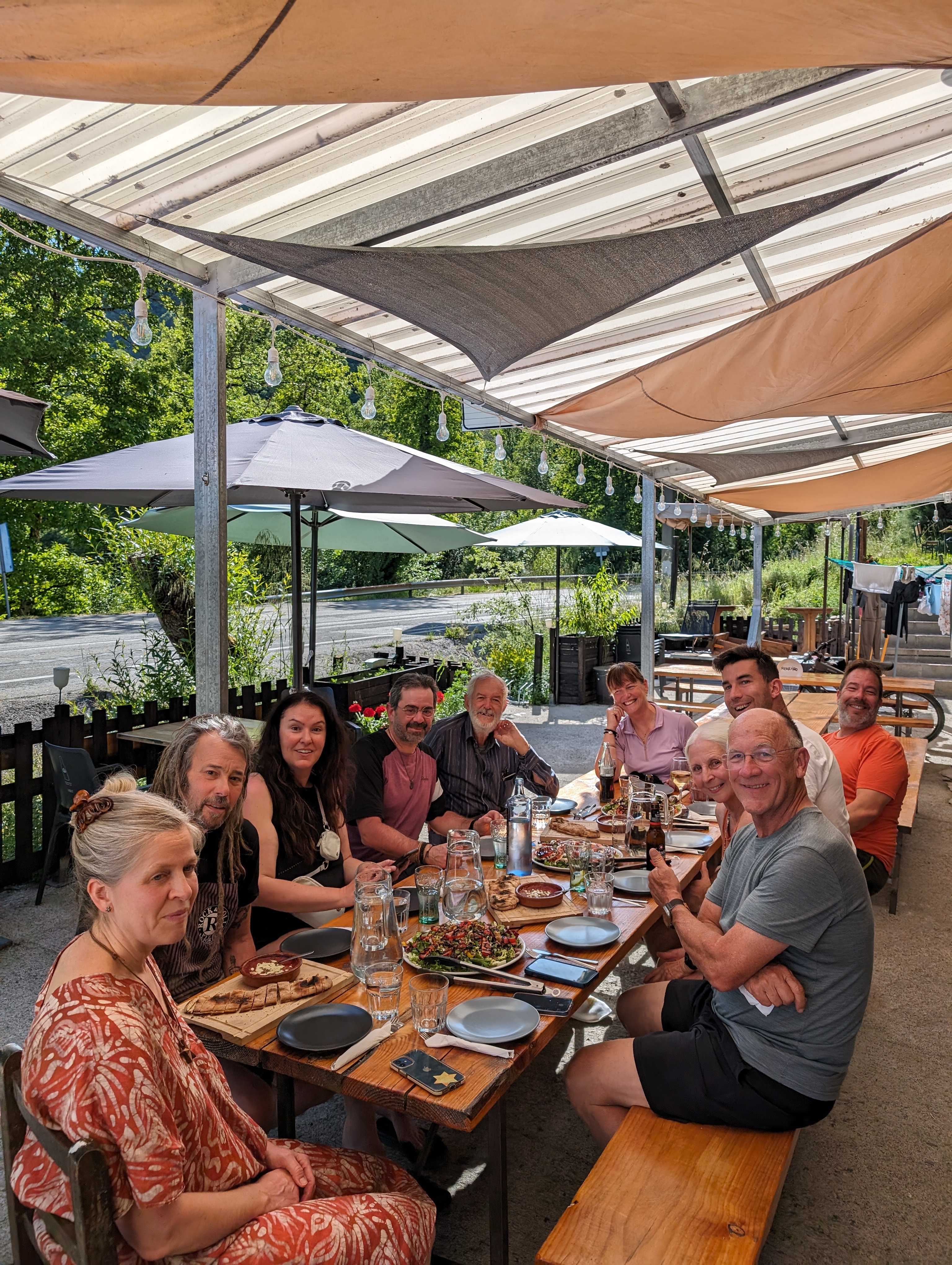
Multicultural dinner

Rock and roll pizza!
Sometimes it makes me sad to lose track of my albergue colleagues. What will happen to them? Will they finish the Camino? Have they recovered from their illnesses or injuries? The old Zimbabwean man had only been able to walk 4 km (about the same distance that separated us from Trabadelo, the previous village). Would he have been able to continue?
Everyone went back to their rooms very soon. I am not able to go to bed at 8 p.m. so, as usual, I am the last one to go to bed. So, after dinner, I hang out on the porch for a while, with my little notebook and fountain pen…
Stage Summary
- Distance: 78 kilometers
- Elevation Gain: 1000+ meters
- Time: About 8 hours, including stops
- Track on Komoot
- Track on Wikiloc
Track
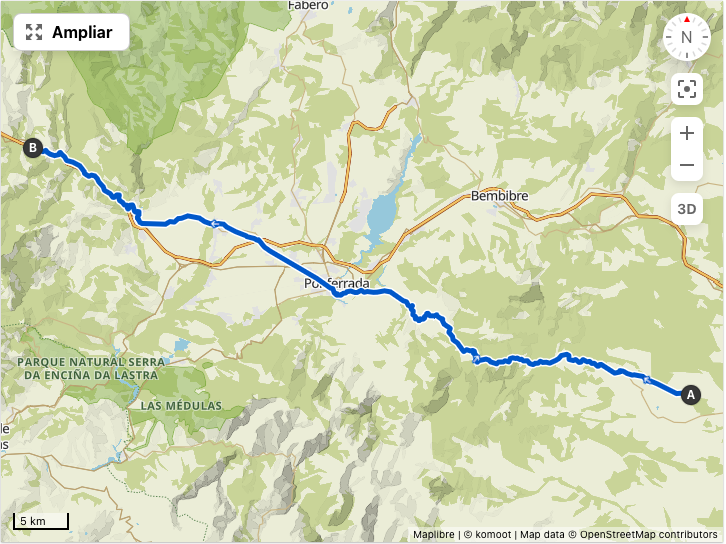
Profile

👈 Day 4: from El Burgo Ranero to El Ganso | Day 6: from Portela to Portomarín 👉